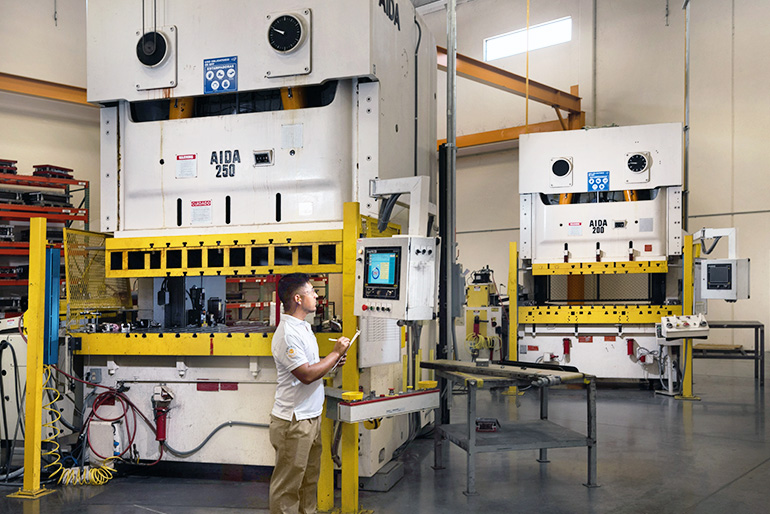Metal Stamping: Advanced Techniques for Achieving Accuracy and Effectiveness
Metal Stamping: Advanced Techniques for Achieving Accuracy and Effectiveness
Blog Article
Exploring the World of Steel Stamping: From Layout to Production
Within the realm of production, metal stamping stands apart as a precise and reliable technique for forming metal sheets right into numerous types with exceptional uniformity. From the preliminary layout phase where complex patterns materialize to the detailed manufacturing procedures, metal stamping is a mix of artistry and engineering. Exploring this globe unveils a complex interaction of imagination and technical mastery, offering a glimpse right into a world where advancement fulfills workmanship.
Background of Metal Stamping
Metal marking, an extensively utilized production procedure today, has an abundant background that dates back to old times (Metal Stamping). The origins of steel stamping can be traced to ancient worlds such as the Egyptians, that utilized stamping methods to decorate jewelry and ornaments with detailed layouts. In time, steel stamping progressed, with people like the Greeks and Romans using it for developing coins and decorative items

In the 20th century, metal stamping remained to progress with the assimilation of automation and computer mathematical control (CNC) modern technology. These developments even more increased the performance and precision of steel marking processes, making it a crucial component of modern manufacturing across sectors such as automotive, aerospace, and electronics. Today, metal marking stays an essential manufacturing process, integrating practice with technology to satisfy the needs of a continuously evolving sector.
Layout Factors To Consider and Prototyping
Design factors to consider in steel marking consist of material option, part geometry, tooling style, and production expediency. Tooling design plays a substantial role in the success of steel stamping projects, affecting component precision, tool long life, and manufacturing efficiency.
Prototyping is a crucial phase in the metal stamping procedure that enables designers to evaluate the style, confirm manufacturability, and make essential adjustments before full-scale production. Prototyping helps determine potential concerns early, saving time and expenses over time. It additionally offers a possibility to optimize the layout for efficiency and quality. By thoroughly thinking about layout facets and using prototyping, manufacturers can simplify the steel stamping procedure and accomplish top notch, cost-effective production end results.
Tooling and Equipment Essentials
Thinking about the vital role that tooling layout plays in the success of steel stamping jobs, recognizing the crucial tools and equipment required is paramount for attaining effective production end results. Tooling is a basic aspect of metal marking, as it straight influences the high quality and consistency of the final products. Essential tools consist of dies, More Help strikes, and fixtures, which are custom-made to form and develop the steel right into the wanted parts. Dies are the main tool made use of to reduce and create the steel, while punches aid create openings or particular shapes. Components hold the steel in place during the marking procedure, guaranteeing accuracy and repeatability. Additionally, devices such as stamping presses, feeders, and coil handling systems are essential for automating the marking procedure and boosting performance. Spending in top quality tooling and devices not only enhances manufacturing efficiency but additionally leads to greater precision, minimized waste, and general expense savings in steel stamping procedures.
Production Refine and Top Quality Control
Efficiently managing the manufacturing procedure and implementing durable quality assurance measures are important for guaranteeing the success of steel marking projects. The production procedure in steel stamping involves a collection of steps that must be meticulously coordinated to accomplish ideal results. It begins with the prep work of raw products, complied with by the configuration of the marking equipment and tooling. Operators then feed the products right into journalism, where the stamping operation occurs. Throughout this procedure, it is crucial to check the manufacturing line for any concerns that might affect the top quality of the stamped components.
Quality control in steel marking is paramount to supply products that satisfy the called for specs. Inspecting the stamped components at various stages of production assists recognize any problems at an early stage, stopping costly rework or scrap. Strategies such as dimensional evaluation, aesthetic great site inspection, and product screening are typically utilized to make sure the top quality of the stamped parts. By maintaining rigorous quality assurance standards, suppliers can support their online reputation for delivering top quality steel marked items.
Applications and Industry Insights
In the world of steel stamping, the effective application of production processes and top quality control measures straight affects the effectiveness and integrity of numerous industry applications and offers valuable insights into the industry's functional characteristics. Steel marking locates prevalent application throughout varied sectors, consisting of automotive, aerospace, electronics, and home appliances. In the automobile field, metal marking plays a critical role in producing components such as framework, braces, and structural parts with high accuracy and effectiveness. The aerospace industry counts on steel stamping for manufacturing elaborate parts like panels, brackets, and fittings that meet rigorous top quality criteria (Metal Stamping). In the electronic devices market, steel marking is utilized to create exact parts like adapters, terminals, and heat sinks. Furthermore, metal stamping helps with the manufacturing of different household devices, consisting of refrigerators, cleaning makers, and ovens, by providing cost-efficient services for manufacturing sturdy and complicated parts. Understanding the applications and sector insights of metal stamping is important for optimizing manufacturing processes and boosting product high quality across various industries.

Conclusion
Layout Going Here factors to consider, prototyping, tooling, tools, manufacturing processes, and high quality control are crucial elements of steel stamping. With its prevalent applications and sector insights, steel marking continues to be a versatile and effective manufacturing procedure.
Report this page